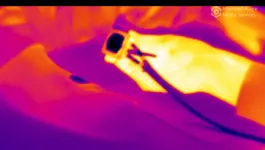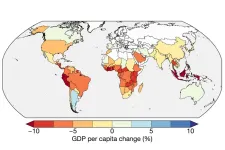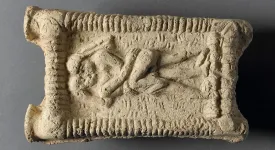(Press-News.org) Highlights:
Michigan State University researchers sequenced the Montmorency tart cherry genome for the first time.
This will have a major impact on all future tart cherry research and breeding efforts worldwide.
Michigan is the nation’s leading producer of tart cherries.
EAST LANSING, Mich. – Since Michigan is the nation's leading producer of tart cherries, Michigan State University researchers were searching for the genes associated with tart cherry trees that bloom later in the season to meet the needs of a changing climate. They started by comparing DNA sequences from late-blooming tart cherry trees to the sequenced genome of a related species, the peach. However, in a surprise to the researcher, the genetic discrepancies between the species outweighed the similarities. This led the team to create the first annotated Montmorency tart cherry genome and identify the DNA segments that code for each gene.
“I naively thought that this would be an easy endeavor; we would simply sequence a few early and late-blooming cherry trees and align the sequences to the peach genome and get an answer in just a few weeks,” said Courtney Hollender, an assistant professor in the College of Agriculture and Natural Resources at MSU. “I couldn’t have been more wrong.”
Genomes contain all the genes and genetic instructions for an organism’s development. Sequencing it provides a map for researchers when they are trying to, for example, grow a cherry tree that will bloom later in the season. For Hollender’s doctoral candidate, Charity Goeckeritz, an exercise in frustration piqued her curiosity.
“I was trying to align the tart cherry DNA sequences with the peach genome and they just weren’t aligning very well,” said Goeckeritz. “I was complaining about it to everyone and, finally, one of my friends suggested we just sequence the tart cherry genome.” Thanks to funds from MSU’s AgBioResearch Project GREEEN, or Generating Research and Extension to Meet Economic and Environmental Needs, they were able to do just that.
Hollender and Goeckeritz teamed up with Amy Iezzoni, MSU professor emerita and the nation’s only tart cherry breeder; Kathleen Rhoades, Iezzoni’s doctoral student; Bob VanBuren, an assistant professor in the Department of Horticulture and MSU’s Plant Resilience Institute; Kevin Childs, director of the MSU Genomics Core; and Patrick Edger, an associate professor in MSU’s Department of Horticulture. Together they found that the Montmorency tart cherry genome was more intricate than they originally thought.
The complexities come from the tart cherry’s parental plant chromosomes. Tart cherries are allotetraploids meaning instead of having two sets of chromosomes like humans, they have four sets from at least two different species.
“Not only does tart cherry have four copies of every chromosome, but it also is the product of a natural cross between two different species,” said Goeckeritz. “The ground cherry, Prunus fruticosa, and the sweet cherry, Prunus avium, that may have happened almost two million years ago.”
While Goeckeritz is using the genome to study bloom time, Rhoades, who conducted the RNA sequencing or gene expression analysis for the project, is working to identify genes that are associated with specific fruit traits, such as color and firmness.
Having the Montmorency tart cherry genome sequence opens the possibilities for a tremendous amount of future research that will ultimately benefit the industry and the consumer by growing more trees that can withstand varying spring weather and produce more cherries.
“Before this genome, there were some sequences for tart cherries but it wasn’t a complete picture, and I just wanted to have the genome for research and breeding purposes,” said Hollender. “Now we have a complete picture, and this research will have a major impact on all future tart cherry research and breeding efforts worldwide.”
The research was published in the journal Horticulture Research.
###
Michigan State University has been advancing the common good with uncommon will for more than 165 years. One of the world's leading research universities, MSU pushes the boundaries of discovery to make a better, safer, healthier world for all while providing life-changing opportunities to a diverse and inclusive academic community through more than 400 programs of study in 17 degree-granting colleges.
For MSU news on the Web, go to MSUToday. Follow MSU News on Twitter at twitter.com/MSUnews.
END
MSU researchers uncover the hidden complexity of the Montmorency tart cherry genome
2023-05-18
ELSE PRESS RELEASES FROM THIS DATE:
Historical fiction: a guarantee of critical success or a trap?
2023-05-18
For 21st century authors, the odds of writing a critical hit are much higher if the novel takes place in the past, not the present or future. Between 2000 and 2020, about three quarters of the novels shortlisted for the National Book Award, the Pulitzer Prize, and the National Book Critics Circle Award took place in the historical past.
“As a reader, you may not have even noticed the growing infatuation with history in literature because the historical novel has become such a diversely practiced form by such a wide array of writers, it's almost become invisible to us as a genre in itself,” ...
Using 3D printing to improve implantable biomedical devices, touchscreens and more
2023-05-18
McGill researchers are exploring a new technique that uses 3D printing and hydrogels. It has the potential not only to improve biomedical implants but could also be useful in the development of human-machine interfaces such as touch screens and neural implants. Biomedical devices like pacemakers or blood pressure sensors that are implanted into the human body need to be fabricated in such a way that they conform and adhere to the body – and then dissolve at the right time.
Using 3D printing and hydrogel technology, researchers in McGill University’s Department of Engineering ...
Amputees feel warmth in their missing hand
2023-05-18
“When I touch the stump with my hand, I feel tingling in my missing hand, my phantom hand. But feeling the temperature variation is a different thing, something important... something beautiful,” says Francesca Rossi.
Rossi is an amputee from Bologna, Italy. She recently participated in a study to test the effects of temperature feedback directly to the skin on her residual arm. She is one of 17 patients to have felt her phantom, missing hand, change in temperature thanks to new EPFL technology. More importantly, she reports feeling reconnected to her missing hand.
“Temperature feedback is a nice ...
In years after El Niño, global economy loses trillions
2023-05-18
In the years it strikes, the band of warm ocean water spanning from South America to Asia known as El Niño triggers far-reaching changes in weather that result in devastating floods, crop-killing droughts, plummeting fish populations, and an uptick in tropical diseases.
With El Niño projected to return this year, Dartmouth researchers report in the journal Science that the financial toll of the recurring climate pattern can persist for several years after the event itself—and cost trillions in lost income worldwide. The study is among the first to evaluate the long-term costs of El Niño and projects losses that far exceed ...
Fear of large predators drives smaller predators into areas they perceive as safer, but where risk is greater
2023-05-18
Medium-sized carnivorous species – mesopredators like coyotes or bobcats – tend to move into human-dominated areas to avoid predation by larger carnivores, a phenomenon also known as the “human shield” effect. However, according to a new study, doing so places these safety-seeking species at considerably greater risk for mortality due to human activities. The findings describe a “paradox of the lethal human shield” for mesopredators, which could become an increasingly important driver of carnivore community dynamics and ecological trophic structures as species restoration and recovery efforts expand the coexistence of ...
Ancient history of kissing and its role in disease transmission
2023-05-18
In a Perspective, Troels Arbøll and Sophie Rasmussen review the ancient history of kissing, particularly the emergence of romantic-sexual kissing in Mesopotamia more than 4000 years ago and its role in the evolution and spread of orally transmitted diseases like herpes simplex virus 1 (HSV-1). They say the kiss cannot be regarded as a sudden biological trigger causing a spread of specific pathogens, as some research has recently proposed. “Evidence indicates that kissing was a common practice in ancient times, potentially representing a constant influence on the spread of orally transmitted microbes, such as HSV-1,” ...
Global analysis reveals widespread decline in lake water storage worldwide
2023-05-18
The amount of water stored in more than half of the largest lakes and reservoirs worldwide is declining, according to a new study. This drying is largely attributable to a warming climate and increased human impacts. The findings underscore the importance of accounting for these impacts in future surface water resources management strategies. Although they cover roughly 3% of the global land area, lakes hold 87% of Earth’s liquid surface fresh water. These features also provide essential ecosystem services and are key components in global biogeochemical processes. Many of these benefits are modulated by lake water storage (LWS), which ...
Unmanaged global forests have limited carbon sequestration potential
2023-05-18
Even if all direct human management of global forests ended immediately, their carbon sequestration potential would not be enough to curb ongoing climate change, according to a new study. The findings suggest that the planet’s current forests have only limited remaining carbon storage potential – even under the most unlikely of scenarios – to substantially mitigate atmospheric carbon dioxide (CO2) without major reductions in emissions. By capturing and storing carbon in biomass and soil organic matter, forests are integral to the global carbon cycle. As a result, the planet’s forests are often considered a central component in climate ...
Half of world's largest lakes losing water
2023-05-18
More than 50 percent of the largest lakes in the world are losing water, according to a groundbreaking new assessment published today in Science . The key culprits are not surprising: warming climate and unsustainable human consumption.
But lead author Fangfang Yao, a CIRES visiting fellow, now a climate fellow at University of Virginia, said the news is not entirely bleak. With this new method of tracking lake water storage trends and the reasons behind them, scientists can give water managers and communities insight into how to better protect critical sources of water and important regional ecosystems.
“This is the first comprehensive assessment of trends ...
Humanity’s earliest recorded kiss occurred in Mesopotamia 4,500 years ago
2023-05-18
Recent research has hypothesised that the earliest evidence of human lip kissing originated in a very specific geographical location in South Asia 3,500 years ago, from where it may have spread to other regions, simultaneously accelerating the spread of the herpes simplex virus 1.
But according to Dr Troels Pank Arbøll and Dr Sophie Lund Rasmussen, who in a new article in the journal Science draw on a range of written sources from the earliest Mesopotamian societies, kissing was already a well-established ...



